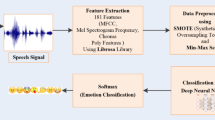Abstract
The primordial way of communication is through vocal signals, which pave the way for support between individuals in a social structure. Computer applications provide a way to create Automatic Speech Recognition (ASR) with a combination of Speech Emotion Recognition (SER) to detect and identify emotions in the speech signals. The semantic relatedness of words with abstract concepts proves to be complicated than concrete ideas. An ensemble of different clustering techniques is utilized to automatically segregate sense distinctions in the various dialects of sentences spoken to tackle this issue. The interpretation of word sense of a word may change with time and group of people. The proposed model maps characters to word sense with weights provided by Senticnet with trial-and-error methods and tuning. The proposed model utilizes stop words to distinguish word senses with 72.78% accuracy for regional dialects.














Similar content being viewed by others
References
Akçay, M. B., & Oğuz, K. (2020). Speech emotion recognition: Emotional models, databases, features, preprocessing methods, supporting modalities, and classifiers. Speech Communication, 116, 56–76.
Bakhshi, A., Chalup, S., Harimi, A., & Mirhassani, S. M. (2020). Recognition of emotion from speech using evolutionary cepstral coefficients. Multimedia Tools and Applications, 79(2), 1–21.
Bernard, M., Thiolliere, R., Saksida, A., Loukatou, G. R., Larsen, E., Johnson, M., Fibla, L., Dupoux, E., Daland, R., Cao, X. N., et al. (2020). WordSeg: Standardizing unsupervised word form segmentation from text. Behavior Research Methods, 52(1), 264–278.
Christy, A., Vaithyasubramanian, S., Jesudoss, A., & Praveena, M. D. A. (2020). Multimodal speech emotion recognition and classification using convolutional neural network techniques. International Journal of Speech Technology, 23, 381–388 (2020)
Gaonkar, R., Kwon, H., Bastan, M., Balasubramanian, N., & Chambers, N. (2020). Modeling Label Semantics for Predicting Emotional Reactions. ArXiv Preprint. arXiv:2006.05489.
Grave, E., Bojanowski, P., Gupta, P., Joulin, A., & Mikolov, T. (2018). Learning word vectors for 157 languages. In Proceedings of the international conference on language resources and evaluation (LREC 2018).
Jermsittiparsert, K., Abdurrahman, A., Siriattakul, P., Sundeeva, L. A., Hashim, W., Rahim, R., & Maseleno, A. (2020). Pattern recognition and features selection for speech emotion recognition model using deep learning. International Journal of Speech Technology, 23(4), 1–8.
Kunchukuttan, A., Kakwani, D., Golla, S., Gokul, N. C., Bhattacharyya, A., Khapra, M. M., & Kumar, P. (2020). AI4Bharat-IndicNLP Corpus: Monolingual Corpora and Word Embeddings for Indic Languages. ArXiv Preprint. arXiv:2005.00085.
Moselhy, A. M., & Abdelnaiem, A. A. (2013). LPC and MFCC performance evaluation with artificial neural network for spoken language identification. International Journal of Signal Processing, Image Processing and Pattern Recognition, 6(3), 55.
Rajendran, S., & Jayagopal, P. (2020). Preserving learnability and intelligibility at the point of care with assimilation of different speech recognition techniques. International Journal of Speech Technology, 23(2), 265–276. https://doi.org/10.1007/s10772-020-09687-x.
Shi, Y., Hwang, M.-Y., & Lei, X. (2019). End-to-end speech recognition using a high rank lstm-ctc based model. In ICASSP 2019–2019 IEEE international conference on acoustics, speech and signal processing (ICASSP) (pp. 7080–7084).
Shivaprasad, S., & Sadanandam, M. (2020). Identification of regional dialects of Telugu language using text independent speech processing models. International Journal of Speech Technology, 23, 251–258 (2020).
Stiennon, N., Ouyang, L., Wu, J., Ziegler, D. M., Lowe, R., Voss, C., Radford, A., Amodei, D., & Christiano, P. (2020). Learning to summarize from human feedback. ArXiv Preprint. arXiv:2009.01325.
Tavares, A. R., Avelar, P., Flach, J. M., Nicolau, M., Lamb, L. C., & Vardi, M. (2020). Understanding Boolean function learnability on deep neural networks. ArXiv Preprint. arXiv:2009.05908
Xu, Q., Likhomanenko, T., Kahn, J., Hannun, A., Synnaeve, G., & Collobert, R. (2020). Iterative pseudo-labeling for speech recognition. Computation and Language. arXiv Preprint. arXiv:2005.09267.
Yang, Y., Yuan, S., Cer, D., Kong, S.-Y., Constant, N., Pilar, P., Ge, H., Sung, Y.-H., Strope, B., & Kurzweil, R. (2018). Learning semantic textual similarity from conversations. ArXiv Preprint. arXiv:1804.07754.
Yoon, S., Byun, S., & Jung, K. (2018). Multimodal speech emotion recognition using audio and text. In 2018 IEEE spoken language technology workshop (SLT) (pp. 112–118).
Yu, C., Kang, M., Chen, Y., Wu, J., & Zhao, X. (2020). Acoustic modeling based on deep learning for low-resource speech recognition: An overview. IEEE Access. https://doi.org/10.1109/ACCESS.2020.3020421.
Author information
Authors and Affiliations
Corresponding author
Additional information
Publisher's Note
Springer Nature remains neutral with regard to jurisdictional claims in published maps and institutional affiliations.
Rights and permissions
About this article
Cite this article
Rajendran, S., Mathivanan, S., Jayagopal, P. et al. Language dialect based speech emotion recognition through deep learning techniques. Int J Speech Technol 24, 625–635 (2021). https://doi.org/10.1007/s10772-021-09838-8
Received:
Accepted:
Published:
Issue Date:
DOI: https://doi.org/10.1007/s10772-021-09838-8




